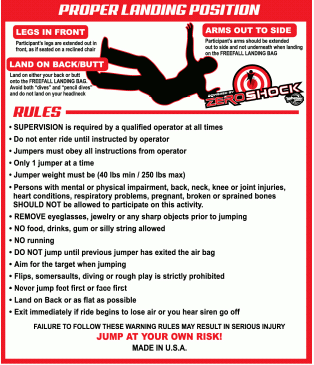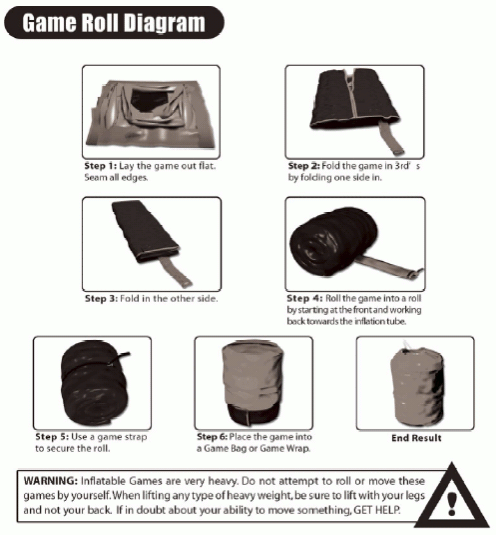| Property | Value |
|---|---|
| Model Number | Cliff Jump |
| Dimensions | 22'6" x 16'2" x 17'7" |
| Inflation Fan Requirements | KP2+ HP Blower (reverse air louver assembly) |
| Minimum Anchor/Tether Points | Eleven (11) |
| Maximum Weight Restriction | 250 lbs, each rider. |
| Minimum Height Requirement | 44", or 3'8" |
| Maximum Height Requirement | 80", or 6'8" |
| Maximum Number of Participants | Two (2) |
| Minimum Number of Trained Operators | Two (2) |
| Total Weight of Unit | 582 lbs |
Operating Instructions
- Attendant(s) MUST be present and operating the inflatable unit at ALL times!
- Set up your Cliff Jump on an incline of no more than 15 degrees.
- Be sure the area that you will be setting your inflatable up is free of all debris including any rocks or sharp objects. Grass or hard ground is fine for set up as long as there are no rocks, debris or sharp objects.
- Lay out a ground tarp to protect the inflatable.
- Footprint of inflated Cliff Jump is: 22%u20196%u201Dx16%u20192%u201Dx17%u20197%u201D
- Required clearance from adjacent obstacles is three feet (3%u2019) around and above the perimeter of the inflatable.
- Required area for inflated Cliff Jump is: 32%u20196%u201Dx26%u20192%u201Dx22%u20197%u201D.
- Unroll the inflatable and attach (1) KP-2+ HP inflation blower (producing minimum 700 cubic feet per minute - Reverse air louver assembly) to the inflation tube(s). Tie off any un-used air tubes and be sure that all zipper / flaps are closed.
- Anchor the inflatable(s) before inflating. Using (11)18" stake OR 24" stake at 75 % depth (i.e. 18") and 5/8" DIAMETER. Staking should be 90 degrees (i.e. perpendicular). Hard ground anchoring 96 lb minimum of sand or water bag. See %u201CAnchoring for soft and hard ground surfaces illustration in manual. (Stakes provided)
- Tie off any unused blower tubes.
- The Cliff Jump is to be anchored by at least (11) anchor / tether points.
- The Cliff Jump should not be operated in wind speeds in excess of 15 MPH. Deflate immediately if wind gusts develop.
- Do not secure the inflatable to a vehicle (or any object) that could be inadvertently moved while the Cliff Jump is in operation.
- You are now ready to inflate the unit.
The trained operator(s) should now perform an inspection of the attraction, including jumping from the platform onto the Zero Shock air bag below. Check top sheet making sure that all ties are tied from the pop up %u201Cfingers%u201D to the netted top sheet. If any are untied, go underneath the sheet and re-tie. The top sheet will then be tied at the bottom grommet strip area, using the bungee cord provided.
(2) Trained operator(s) should be present at all times. Under no circumstances should the Cliff Jump (or any inflatable), be left unattended! During operation of the Cliff Jump, (1) trained operator(s) should stand in front of the entrance. Operator(s) should stay at the front entrance directing patrons when to enter and make sure that the rider at top of the platform has safely jumped from the platform to the zero shock cushions below and exited safely and off of the inflatable before the next jumper can jump. (1) Trained operator(s) should stand at the top platform and point out and make customers aware of the posted warning sign on the front or side of the inflatable, showing proper and improper jumping. Operator(s) should keep all spectators at least 3%u2019 away from attraction.
Rules of Safety
- No sharp objects.
- No glasses or other eyewear.
- No shoes.
- No food, chewing gum, or drinks.
- No jumping, dives, "pencil" dives, or flips.
- No climbing on the sidewalls.
- No fighting or rough play.
- No double riders.
- No drugs or alcohol. Don't attempt this ride while under the influence of either.
- Do not participate if you have physical injuries or major medical conditions. These include but are not limited to:
- Broken or sprained bones. Even if you're in a cast.
- Current or previous injuries to the back or neck.
- Chronic joint conditions, such as the knee.
- Respiratory conditions such as asthma or bronchitis.
- Other major medical conditions, especially heart or lung conditions.
- Pregnancy.
- Do not enter ride until permitted by operator and previous jumper has exited the air bag.
- Only one jumper at a time.
- Aim for the target when jumping. Land on your back or the back of your butt, as flat as possible.
- Never jump feet or face first.
- Jump with legs in front extended out as if you were seated on a recliner chair.
- When jumping, arms should be extended out to the side and not underneath.

Participants should be instructed to leave the unit in a calm and controlled manner if these situations occur:
- Deflation due to unit puncture/damage or power failure.
- Inclement weather (due to risk of thunderstorm and lightning).
The total deflation time on this unit is approximately five minutes. Should such an event occur, the trained operator(s) should advise the participants on an orderly exit and disallow new participants from entering the attraction until it is fully reinflated.
Ready to Play?
Once the game has been inspected and the operator has jumped onto the Zero shock air bag, the trained operator will stand at the front entrance of the unit, and instruct (2) riders to climb the steps to the top platform and jump from the platform to the Zero shock crush cushion below. From there, they exit out the front of the unit and the attendant directs the next jumper to jump. Only (1) jumper allowed onto the Zero Shock Air Bag below. The next jumper can jump once the first jumper has exited the game.
Rolling Procedure
Step 1: Before breaking down any game, you should remove all accessories that may be applicable to game. Also be sure to use a quality broom and sweep the surface of the game free of any debris. Check to make sure that no sharp objects have fallen into the seams of the game, i.e pens, pencils, etc%u2026 Items such as these can cause minor / major damage to the game during the rolling process.%u2019
Step 2: Unplug the blower. As the game begins to deflate, go around and open all of the deflation flaps that may be located on sides or back of game. Allow the game to deflate to its natural state. Walls may have a tendency to fall outward. Depending on the inflatable, it could take from 5-15 minutes to deflate completely.
Step 3: Folding the game%u2026 You will need a second person to help fold the game. At this point, you will want to fold the game in thirds. Each helper will grab a corner and at the count of 3, you will both fold the game over. You may not get a perfect fold, so walk the game (shoes off) and try to line up so that both ends match. Repeat the same procedure for the other side. To help the air out of the inflatable, be sure that the blower tubes are facing out and walk the inflatable towards to blower tube to walk the air out if possible. Depending on the game, the game should be approx 3%u2019-4%u2019 wide X whatever length applies.
Step 4: Rolling your inflatable%u2026 As noted above, you want to roll the inflatable so that the inflation tubes are extended out making it easy to walk the air out of the inflatable so the inflatable becomes pretty flat making for an easy roll. Roll your inflatable from the front to the back of game. 2 people should roll the game tight much like a sleeping bag. If you have a third persons help, have the third person walk inside of the roll, again helping the air escape and smash down any bumps of vinyl to ease in the rolling process. Be sure that your roll is straight on both sides and tight. As you come towards the end of the roll. Take the game strap and place it as far under the rolled inflatable as you can reach so that when the game is completely rolled, one helper can grab the end, another can grab the other end. Game straps may have an %u201CAlligator%u201D mouth or a D-ring to bring through to tie the game strap to the inflatable.
Step 5: With both persons helping, stand game on end. Place the storage bag over one end of the game and work down as far as you can to cover the entire inflatable. Rotate the game 180 degrees and pull the bag up over the top of the game. Tie the bag closed. Lay the game onto a four wheel dolly and roll it backwards to the storage area.

Notes
If there are any signs of wear on your inflatable game such as orn seams, tears in the vinyl, broken zippers, slide / top sheets wearing out, etc, please contact United Inflatable Rides, who will send the inflatable in for immediate repair.
Your inflatable is made of a PVC coated vinyl, is Flame Resistant and meets or exceeds National Fire Protection Association (NFPA) test method 1 and test method 2. The Flame Resistant material used will not be removed by washing.
Your inflatable is Flame Retardant and Phthalates free.
Your inflatable can be washed (while inflated) with water and a mild cleaner/ degreaser. Allow unit to dry completely before packing up so mildew / mold doesn%u2019t occur. Harsh cleaners or bleach should not be used.
If you have any questions or further assistance, you may call Inflatable 2000, Inc. at (626) 969-7780 / For emergencies, call (626) 926-5127 . Manufactured by Inflatable 2000, Inc. 207 N. Aspan unit 6, Azusa, CA 91702 USA.
© United Inflatable Rides. All rights reserved.
Powered by EventRentalSystems
